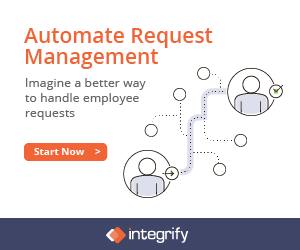The Hidden Costs of Poor Internal Customer Service
By Joanne Wortman ![]() | Published December 19, 2016
| Published December 19, 2016
Related:
Of course, every business understands the need to maintain a high commitment to providing excellent customer service. Oddly enough, some businesses still ignore the hidden costs of poor internal customer service. The reason is simple. Management doesn't even realize or acknowledge that internal customers exist.
Who is an Internal Customer?
We define an internal customer from a business process perspective as any employee who has the authority to place constraints, requirements, or demands on the following aspects of the process:
- When it should start - what kicks it off
- How it should be performed
- Who plays a role in the process
- How long it should take
- What the outputs are
- What is an acceptable level of quality for the outputs of the process
- What should be done in the event of process failure
A good process analyst captures this information when processes are designed or refined. However, high performing businesses are moving into an era of DIY process improvement, leveraging nimble, cloud-based tools for workflow design and automation. In today's world, a business analyst shouldn't always be a separate role or an outside consultant. These skills need to be cultivated within the workforce itself so that workflows can be continuously improved by process customers and those who play a role in performing the process.
Internal Customers are Everywhere
 There are some departments whose internal customers are the entire business! HR, Payroll, Security, Housekeeping/Maintenance, and IT serve every employee in the business at some time or another.
There are some departments whose internal customers are the entire business! HR, Payroll, Security, Housekeeping/Maintenance, and IT serve every employee in the business at some time or another.
At a deeper level, there are departments that are customers of other departments at an individual process level:
- Customer Service may be a customer of the Engineering department when resolving product safety or defect inquiries.
- Marketing may be a customer of Sales when Sales needs new content to drive outreach, or new collateral to take to networking events.
- Payroll is the customer of every manager who must approve employee time and expense submissions before the pay run can start.
- Finance is the customer of Accounting with respect to period closing processes.
- Legal and Compliance can be customers who place regulatory constraints on processes, but they are often information providers of customers throughout the business who need guidance in handling new situations or speedy review of pending contracts.
Hidden Costs of Ignoring Internal Customers
If you consider the hidden costs of poor internal customer service, you will understand why your business needs to tighten up these interactions. There are direct costs, such as:
- Fines when a process does not fulfill regulatory constraints of the requirements that Legal or Compliance places as an internal customer.
- Late payment charges when a manager does not approve a vendor invoice when requested by Accounts Payable as a customer.
- When Engineering does not respond completely or quickly to Customer Service about an expensive defective product, part, or assembly, there is a direct cost related to the particular item returned. There may also be costs related to a product recall if there is an issue with the design or an isolated production batch.
Some hidden costs of poor internal customer service are less direct:
- When an accounting department fails to follow the requirements of the Finance Department (usually in terms of GAAP or timeliness), public companies may need to issue a negative earnings restatement. This causes the stock value to drop.
- When Marketing does not respond to Sales and deliver new messaging or collateral there is a lost opportunity cost of contacts who did not become customers.
- The Sales Order Management team is an internal customer that requires the sales team to hand them complete and correct order information. Delay in order processing reduces cash flow, and may result in a customer cancelling the sale.
Some costs are even less direct.
An HR department that does not acknowledge or address employee complaints can cause high employee turnover. Shoddy maintenance or lax housekeeping can also factor into employee turnover. Most new employees take six to 12 weeks to become productive. Can your business afford that productivity gap?
An IT department that blends development and support roles is often too constrained to provide adequate internal service levels. For an interesting read on this situation and how to resolve it, pick up the Phoenix Project.
The Key to Improving Internal Customer Service
I hope this post has opened your eyes to the importance of improving internal customer service across your business. You may be wondering how to tackle problems in this area. The key to internal customer service improvement is better workflow management that structures work and alerts the workers so that they don't rely on endless email threads or hand-written to-do lists.
The good news is that there are workflow tools available to help speed up and improve internal customer service. These tools are cost effective, easy to learn and use, and can be installed and maintained without placing too much of a burden on IT. They can be part of an improvement effort that begins within a single department. As customer service levels within that department improve, the same tool can be used by other departments to tighten up their workflows. There is no need to wait for a large company-wide process improvement program.
When evaluating a workflow tool, look for the following features:
- Easy visual tools for process diagramming
- Built-in process for designing, editing, approving, and publishing new processes or workflows
- Inherent workflow automation (routing and alerts, ability to capture the required complexity of your business rules)
- Data capture via easy to design forms
- Ease of data integration with existing applications
- Easy to understand KPI tracking and reporting
Hit the Ground Running in 2017
The end of the year is always a good time to reflect and plan for a good start after New Year's Day. Think about internal customer service within your business or organization and make 2017 the year that you make a commitment to improving service levels. If you begin in January, you will start to see bottom line improvement within the first quarter as you reduce the hidden costs of poor internal customer service.
Sources
http://smallbusiness.chron.com/internal-customer-external-customer-11698.html
http://www.donnaearltraining.com/Articles/InternalCustomerService.html
https://www.entrepreneur.com/article/51804
Tags
customer service HR operations Request Management service
Categories
Business Ideas Department Focus News

Joanne Wortman
Joanne Wortman is an independent business/technology consultant and freelance writer in the NY Metro area. She has almost two decades of experience providing business process optimization, organizational change management, M&A integration, and program management across many business sectors, with a concentration in manufacturing.